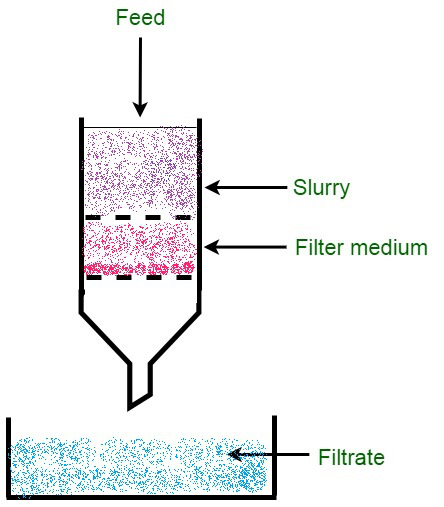过滤分离
泡茶就是最典型的例子。泡茶时使用过滤器或筛子将茶叶与水分离。只有水会流过筛孔。滤液为过滤后收集的液体;在这个例子中,水是滤液。纸、布、棉绒、石棉、矿渣或玻璃棉、无釉陶器、沙子或任何其他多孔材料都可以用作过滤器。过滤用于水和污水的处理。
什么是过滤?
Filtration is a separation technique that uses a porous medium that retains the solid substance but allows the fluid to penetrate through it. It is the process of removing insoluble substances from the solution.
该过程使用过滤介质(例如滤纸)进行。与要提取的颗粒的尺寸相比,使用过的过滤介质的孔更小。该过程通常可用于任何非均相混合物的分离。

过滤原理:过滤过程依赖于颗粒之间大小差异的原理。它以一种物质溶解在溶剂中而另一种不溶解的方式选择溶剂。因此,后者作为所选过滤介质上的残留物被收集。
过滤过程
- 不溶性固体分散到液体中形成溶液。
- 使用玻璃棒将滤纸锥固定到漏斗中。
- 与不溶性固体的颗粒相比,滤纸的孔更小。因此,固体作为滤纸中的残留物被提取出来。
- 然后将滤纸放在网上以提供支撑。
- 重力作用于液体介质。
- 在过滤介质上获得浆液。由于产生的压力差,流体通过过滤介质并在烧杯底部作为溶剂收集。

影响过滤的因素
- 所用固体的性质:
- 颗粒形状和大小
- 粒子电荷
- 粒度分布
- 颗粒粘附在一起的特性
- 密度
- 施加压力的刚性
- 所用液体的性质:
- 使用液体的密度
- 粘度 - 滤液粘度的增加将增加流体中的流动阻力,导致过滤速率降低。
- 悬浮温度
- 浆液中固体的性质:过滤初始阶段的滤饼形成速率。
- 过滤介质的表面积:过滤速率与滤床的比表面积成反比。但是,它与过滤介质成正比。因此,使用大过滤器会提高过滤速度。也可以通过并联多个小单元来增加。
- 过滤介质的压力:蒸发速率与滤饼和介质的压力成正比。通过保持浆液在过滤介质顶部的前方可以获得压力差。
过滤类型
过滤可以大致分为两个不同的类别:
- 表面或筛网过滤
- 这是一种筛分作用,介质的孔通过该作用破坏固体的运动。
- 这种类型的过滤涉及过滤技术。这是一种技术,其中大于过滤介质孔径的颗粒将保留在过滤介质上。这是通过使用带有孔的板或编织筛子来完成的。
- 这种方法的功效是根据平均或最大孔径来定义的。
- 通常,过滤介质的机械强度较小。
- 通常观察到低容量。
- 保留颗粒的尺寸被认为大于中孔尺寸。
- 设备通常很昂贵。
- 例如纤维素膜过滤器。
- 深度过滤
- 这是一种渗透过程,其中浆料深入到固体颗粒直径大于曲折空隙或通道直径的位置。
- 这种类型的过滤涉及缠结技术。这是一种技术,如果过滤介质是布或多孔毡,颗粒会以纤维团的形式缠绕在一起。
- 认为颗粒的尺寸小于孔径。
- 通常,过滤介质的机械强度较高。
- 通常观察到高容量。
- 设备一般都很便宜。
- 例如陶瓷过滤器。
过滤分离的应用
过滤法分离的一些应用是:
- 准备咖啡和茶:热咖啡作为滤液获得,而咖啡豆作为残留物留在过滤器顶部。
- 通过这种技术可以分离白垩粉和水的混合物。
- 真空吸尘器配有过滤器以吸收灰尘颗粒。
- 从水或白垩粉中过滤沙粒。
- 污水和废水处理:过滤是模拟水处理过程的有用技术,但该过程成本高昂且繁琐。
- 由熔炉用来模拟防止熔炉元件被颗粒物污染。
- 空气过滤器用于清除建筑通风系统和内燃机中的空气颗粒物。
- 饮用水废水处理是在慢砂过滤器中使用生物膜过滤进行的。
- 液体剂量的生产
- 肾脏中的血液过滤
示例问题
问题 1:如何克服因粘度增加而导致蒸发速率下降的问题?
解决方案 :
The problem of a decrease in the rate of evaporation due to increasing viscosity be overcome by following methods:
1. Heating the liquid to increase its temperature.
2. Dilution can be simulated in order to increase the rate of evaporation.
问题2:滤饼是什么意思?
解决方案:
A filter cake is formed by the particles or substances that are retained on a filter during the process of filtration. The filter cake usually comprises filter aids, such as activated carbon in order to increment the flow rate or achieve a smaller micron filtration. The filter cake grows thicker than particulate matter as the process of filtration proceeds.
问题 3:定义浆料?
解决方案:
The slurry is basically a liquid-solid fluid mixture with a value of specific gravity greater than 1. The slurry is made to pass through each of the filtration chambers, under pressure delivered by a slurry pump.
问题4:简述过滤介质的种类。
解决方案:
The two major types of filter media are:
- Thin barriers, exemplified by a filter cloth or filter paper;
- Thick barriers, for instance, sand beds, or porous metal.
问题 5:如何在泡茶中使用过滤?
解决方案 :
A sieve or a mesh filter is used as filter paper in order to separate tea leaves from the water. As a result, the tea leaves remain as residue on the sieve whereas the water with the flavor of tea leaves comes out as filtrate.
问题 6:我们有沙子、盐和水的混合物。你将如何分开它?
解决方案 :
Salt gets dissolved in water and forms a solution. It can be separated from the solution using evaporation. Now, the mixture of sand and water remains. The sand settles at the bottom and remains undissolved as a residue. It can be separated by passing the mixture through a filter paper which results in the collection of sand as a residue and water collects as a filtrate.
问题7:过滤工艺的基本要求是什么?
解决方案 :
The basic requirements for filtration are as follows:
- Filter medium;
- Fluid with suspended solids
- Pressure difference to cause fluid to flow;
- Filter that holds the filter medium, contains the fluid.